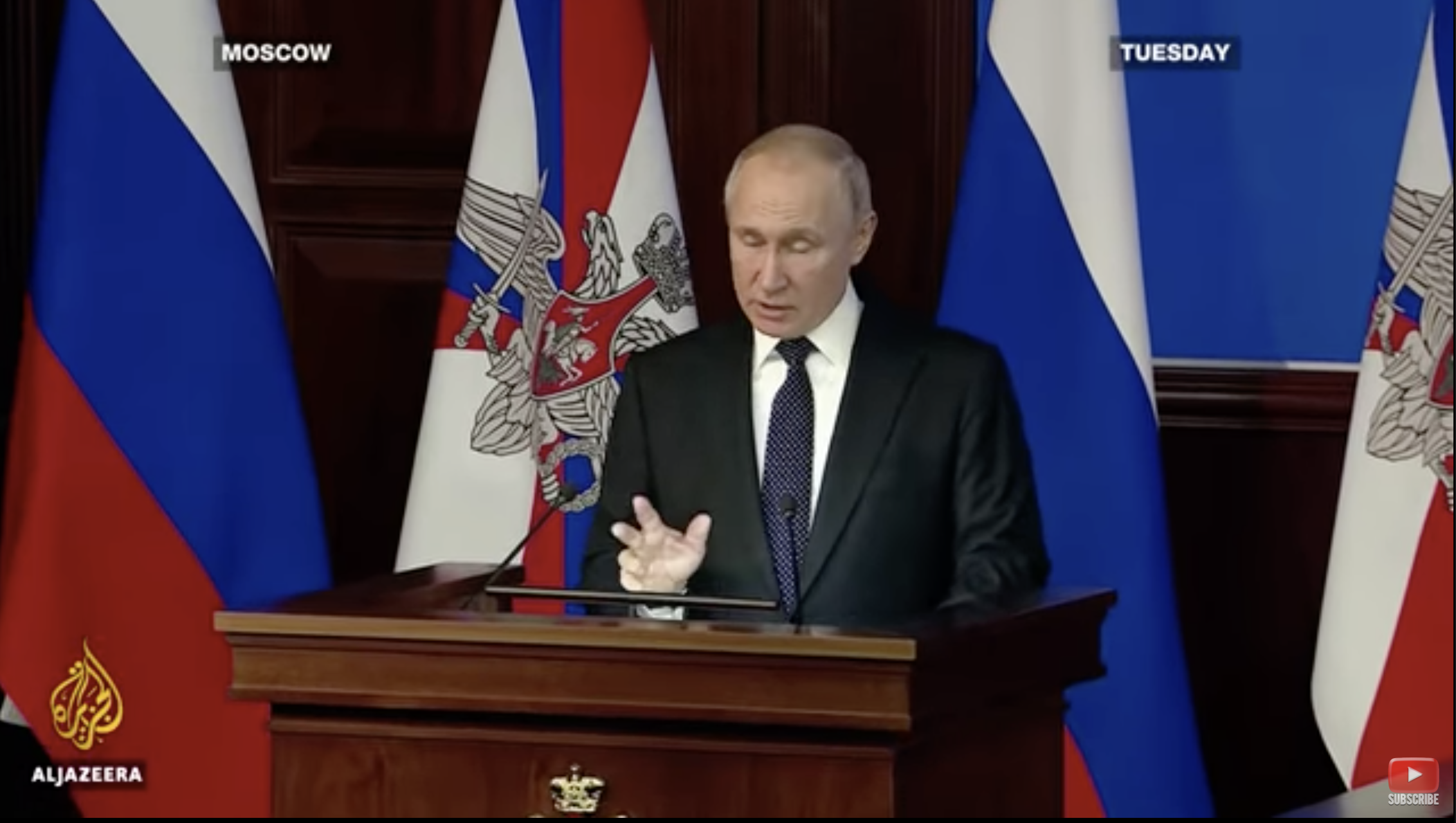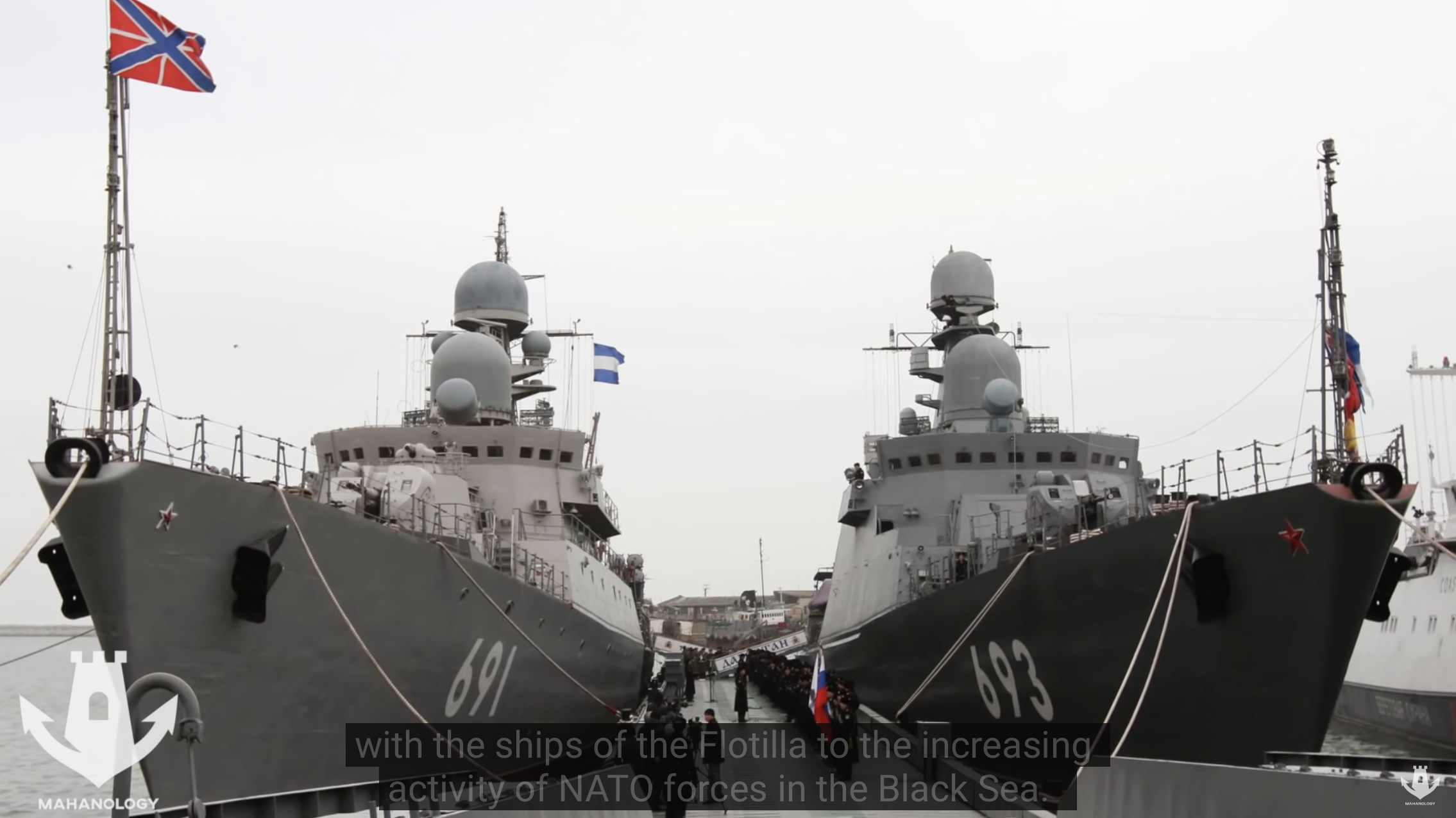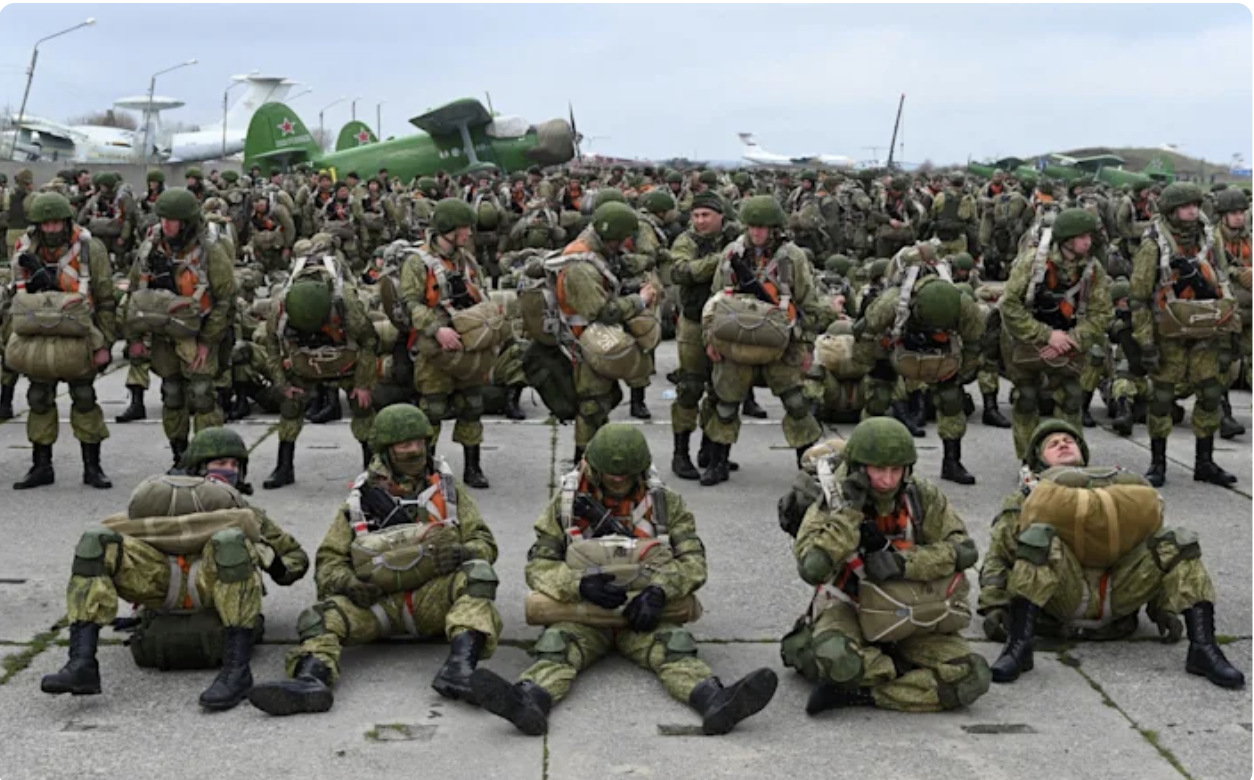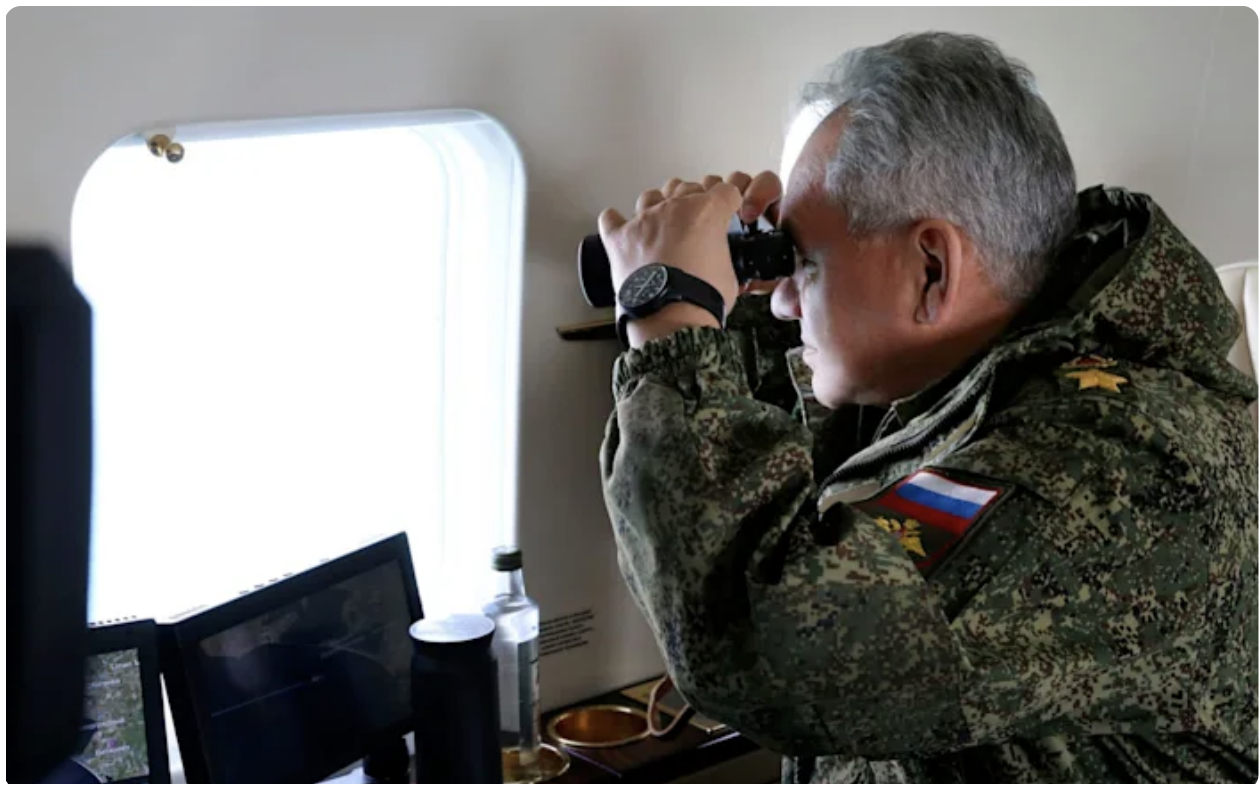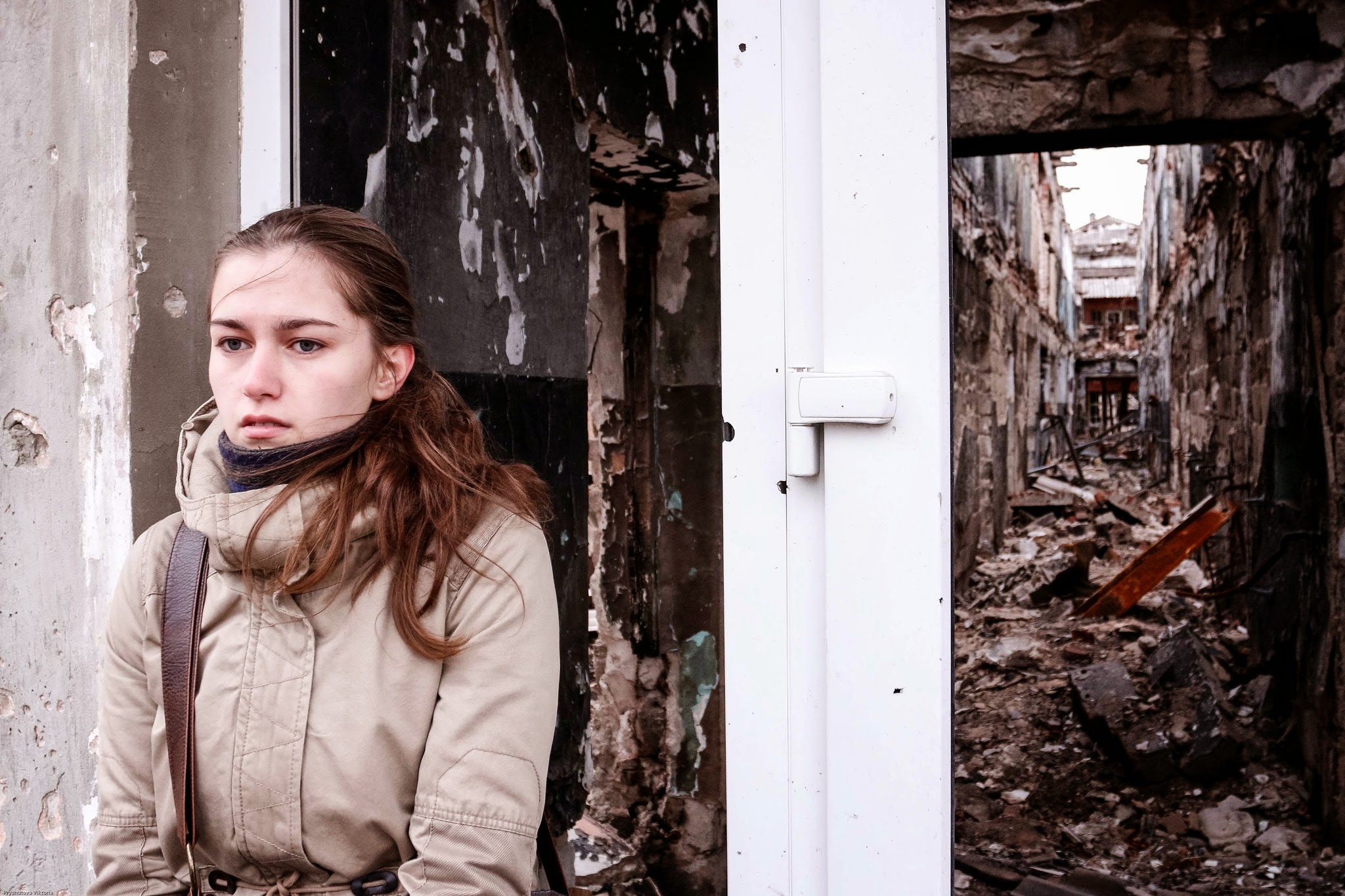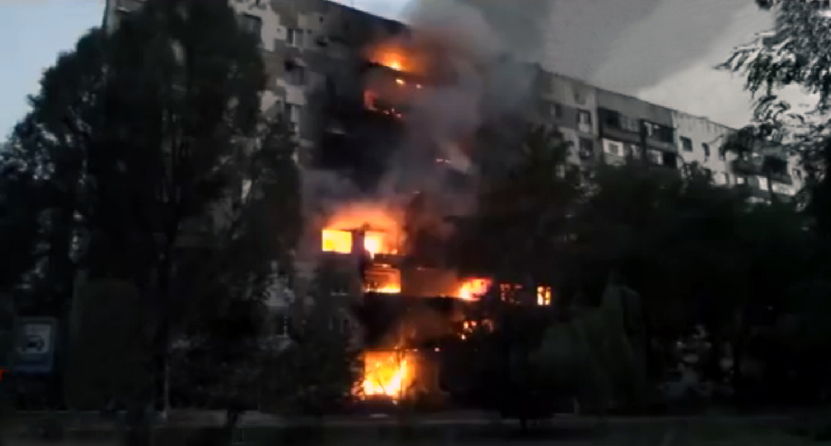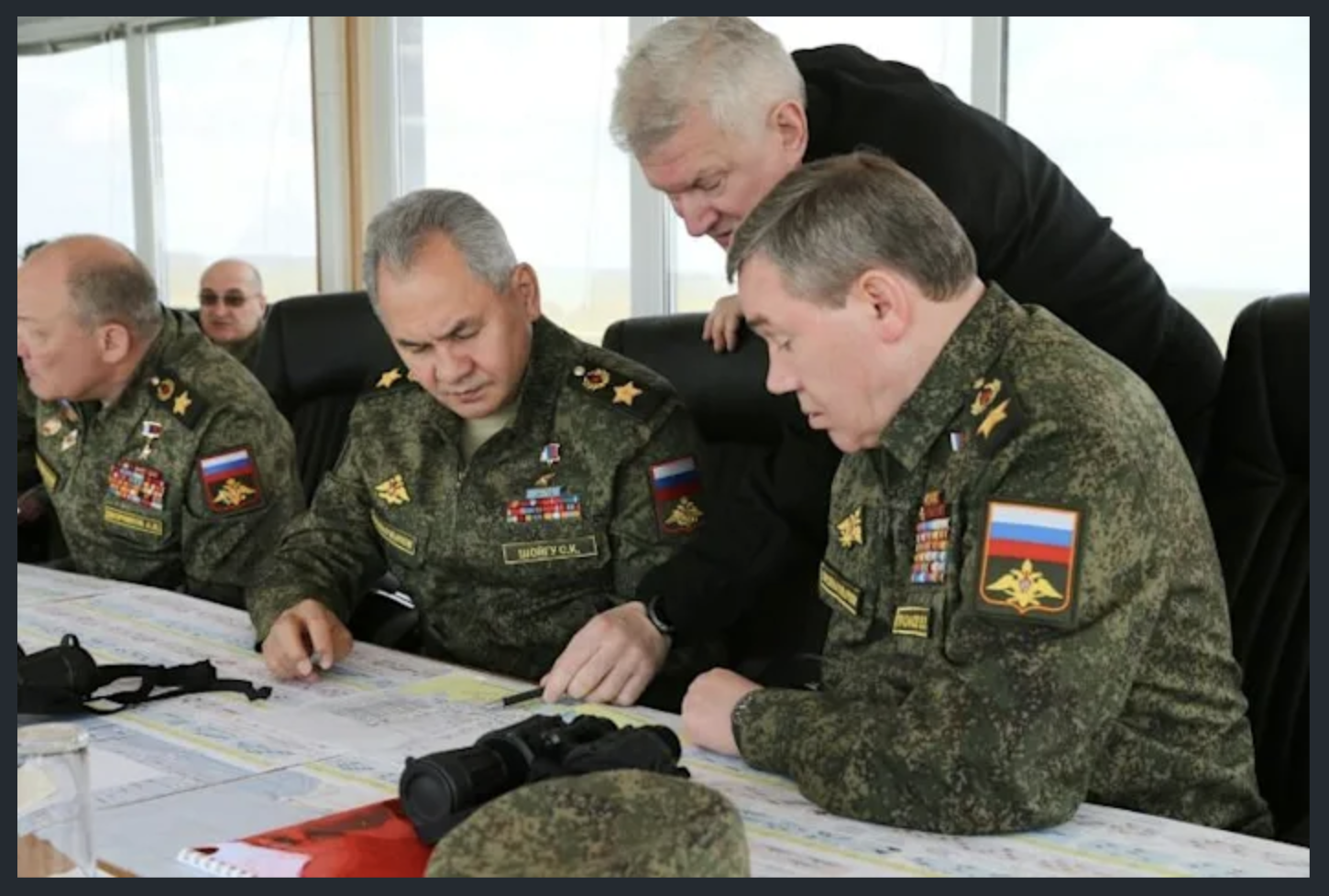
Russia's defense minister Sergei Shoigu (holding pen) discussing plans with Chief of General Staff Gen. Valery Gerasimov.
Before we look into what just happened in the Ukraine, we need to first recall the sequence of events that lead to the current situation. I will try to make a short summary (skipping a lot of details) in the bullet-point style:
- Whether Ze initially intended to stop the war in the eastern Ukraine we don’t know, but what we do know is that he failed not only to stop it, in many ways his policies were even worse than Poroshenko’s. This might be the well-known phenomenon of a supposedly “pro-peace and happiness” politician being accused of being “weak” and thus not “presidential”; this politician has to show his “strength”, his “patriotism”, that he is acting recklessly on the external front. We see that from putatively “liberal” politicians such as the Dems in the USA and Labor in Israel. Historically, “liberals” are the most common war initiators. Ze showed his weakness almost from day 1, and the Ukronazis immediately seized this opportunity to engage in a massive multi-level campaign for war against Russia. This resulted in:
- A quasi-official repudiation of the Minsk Agreements and Steinmeier Formula by Kiev, followed by a sharp increase in bellicose statements and, most crucially a large scale move of forces (including tanks, heavy artillery, MLRS and even ballistic missiles!) towards the line of contact. At the same time Ukronazi politicians began making statements saying that a) the Ukrainian army was capable and willing to “liberate” all of the “Russian occupied” Ukrainian land thus, including both the Donbass and Crimea b) that Russia was going to attack the Ukraine anyway and c) that the consolidated West had to help the Ukraine because only the Ukrainian forces were keeping the Asiatic drunken Russian hordes from over-running not only the Ukraine, but even the rest of Europe. Since the Ukraine simply has no agency, this begs the question of the US (and, to a lesser degree, the UK) rationale was for these moves. It is quite simple:
- Force Russia to openly intervene to protect the population of the Donbass from the inevitable genocide which the Ukronazis would have meated out to the population of the LDNR.
How good was this plan? I would argue that it was a very solid plan which, for the USA, meant a win-win situation. Here is how it should have gone:
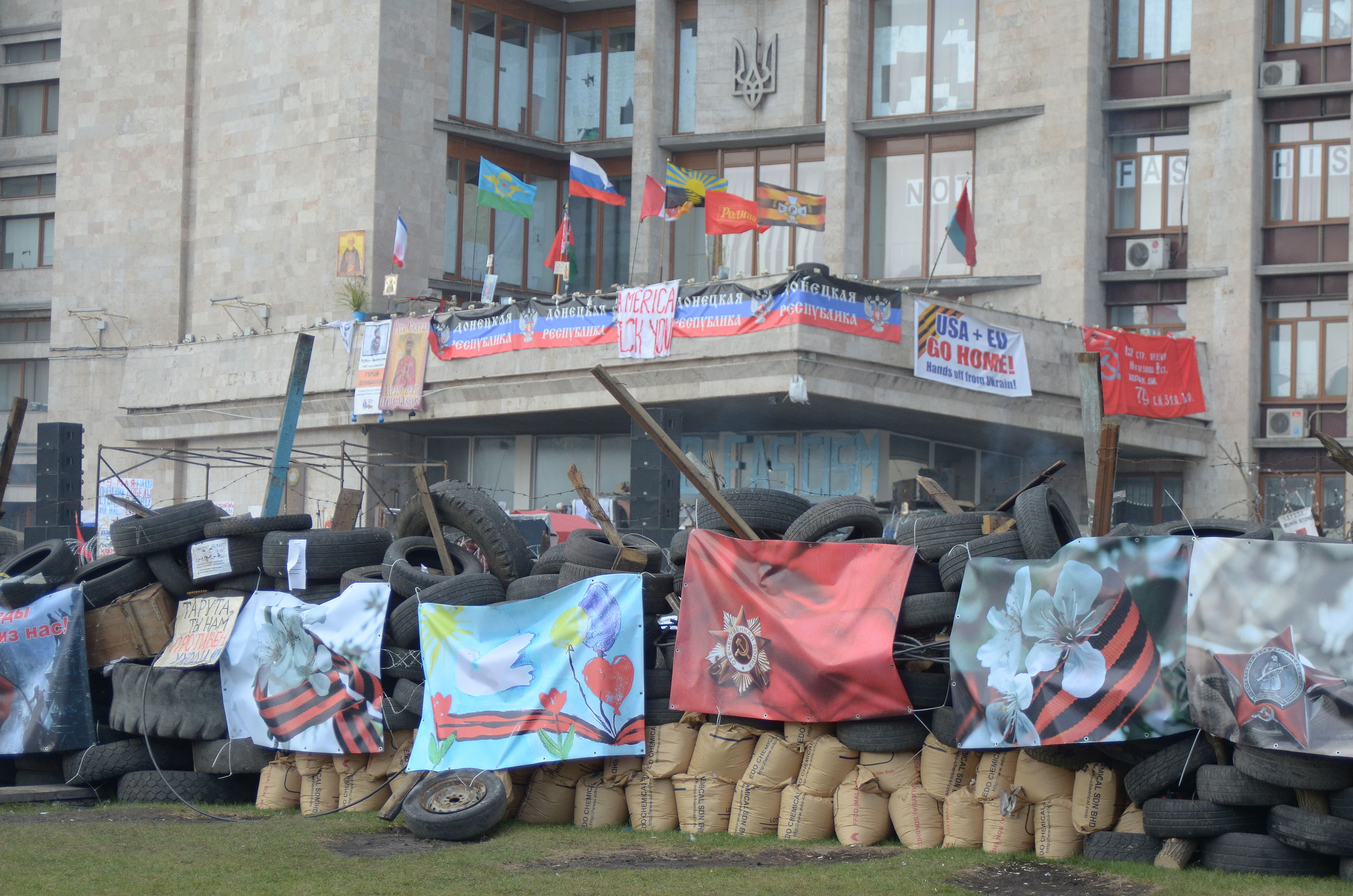
The pro-Russia separatists' feelings are clear in this photo dated 2015, telling the EU and US "to go home!" They know who their enemy is.
First, the Ukrainian forces would attack the LDNR, probably along three axes: one between the city of Gorlovka and Donetsk, one frontally attacking Donetsk proper, not to invade the city, but to tie down LDNR forces in protection of their capital, and one in the south with the aim of reaching the Russian border. This way, the LDNR defenders would have to defend their capital while, at the same time, risking envelopment on two axes. Remember that the LDNR has no strategic depth (Donetsk is practically on the frontline) and that the LDNR defenders could not trade space for time.
[Sidebar: I have seen some “experts” saying that since the Ukrainians have laid down a very large number of mines they are clearly not going to attack since they would lose time – and possibly men – to cross these minefields. First, there is no way of knowing if these mines are real or fake (many mines also have a timer anyway) but, second, more crucially: an attacking force always wants to concentrate in one specific location of the line of contact, which means that the attacking forces has to not only attack, but also protect herself from enemy counter-attacks: minefields are very effective at providing this sort of protection. The “defensive” moves can, and do, in reality, form an integral part of any offensive plans]
Of course, The Big Question was this: could the LDNR forces stop the Ukronazis? There are those who say that yes, and those who say no. Rather than suggesting an answer, let’s look at both of these outcomes:
Option 1: the LDNR forces successfully stop the Ukrainian invasion:
That would be, by far, the best outcome for Russia, but for the LDNR this outcome, while better than a defeat, would probably result in a lot of deaths and destruction. We know that both the Ukrainian military and the LDNR forces have been profoundly reformed and restructured since 2014. Crucially, the LDNR forces went from being self-organized and disparate militias to a conventional military force capable of operational level combined arms operations. Would that be enough to stop a larger Ukrainian force? Possibly. But this is by no means certain, not only because war is an unpredictable thing to begin with, but also because we really have no way of knowing how well the Ukrainian military was reformed. If what they got was the same type of “training” as the Georgians in the years leading up to 08.08.08 then there is a good cause to doubt it. LDNR leaders, however, did not engage in bravado and silly flag-waving and they took the threat very seriously, which tells us that they were by no means certain of what might happen next. Now let’s look at option 2:
Option 2: the LDNR defenses eventually collapse in one or even several locations:
What if the LDNR forces failed to stop the Ukrainians? At this point, Russia would have absolutely no choice but to intervene to save the people of the Donbass (more than half a million of which already have Russian passports!). I won’t discuss here the options a LDNR+Russia counter-attack would have or how much Ukronazi-occupied land Russia could or should liberate (that is not the topic here). In this case, two things are absolutely certain:
- Russia would comprehensively defeat any combination of Ukrainian forces.
- The US/NATO would declare a state of quasi war with Russia and create something similar to the Berlin Wall along whatever line of contact would result from a Russian counter-attack.
In this scenario, the biggest loser would, of course, be the Ukraine. But the next loser would be Russia, because instead of “just” dealing with a nutcase Nazi regime next door, Russia would now face a hysterically paranoid and Russophobic consolidated West. At the end of such a war, Russia would face something similar to what happened at the end of the Korean war: a ceasefire followed by decades of tensions.
The big winner would be the USA: its main instrument for the colonization of Europe (NATO) would finally find itself a purpose in life (stop the Russians, of course), NS2 and other cooperation between the EU and Russia would all but totally freeze, making the European economy non-competitive against the US, and the US MIC would have a great time selling very expensive, if not very effective, military hardware to all the European countries. And that strategic US victory would not cost the US a single soldier! What’s there not to like about this?
Well, for Russia this would be a very bad outcome. Yes, Russia has the means to take on both the US and NATO militarily, but politically and economically, this would hurt Russian interests, not critically, but substantially.
Then, there is this: the Ukraine is a thoroughly deindustrialized failed state, worse than many African countries. While there was a lot of window-dressing going on both inside the Ukraine and in the West’s legacy media, the COVID pandemic and its horrible consequences inside the Ukraine became impossible to conceal or deny, especially to the Ukrainian people themselves. Right now, the entire Ukraine is like a vase in a store: if you break it, you own it and you must fix it. Even if we exclude an outcome where the Russian tanks stop at the western borders of the Ukraine and take a middle-of-the-road option where the Russians stop at the Dnieper river, this would have huge consequences for the Russians, including:
- The frontline between the Ukronazis and the LDNR+Russian forces would be massively stretched becoming much longer, yet every kilometer of that line of contact would have to be protected. This begs the question: protected by whom?
- The Russian side would suddenly inherit several large cities (Chernigov, Kharkov, Poltava, Dnepropetrovsk, Zaporozhia, Mariupol, Berdiansk, etc.). Not only would the Russians have to clear these cities from Ukrainian insurgents and stay-behind forces, but Russia would also have to rebuild them and feed a population much larger than the current population of the LDNR.
- The Russian economy simply cannot bear the burden of what is currently a Nazi run Ukraine which has turned into a massive black hole sucking in huge resources and never letting anything leave (except emigrating Ukrainians). At best, Russia is currently investing billions of rubles to rebuild Crimea (which the Nazis always hated and neglected – except to build themselves mansions on the Black Sea) while barely keeping the LDNR afloat.
It is the consolidated West (US+UK+EU) which destroyed the Ukraine, and the Russians will capitalize on this by making the West responsible for fixing what it broke, and that won’t happen since the EU does not have the means to do it right now while the USA is not directly threatened by this situation and thus has no reason to intervene beyond making sure that the regime in Kiev remains a) rabidly anti-Russian and b) totally under the control of the USA.
Thus, neither option 1 nor option 2 were desirable for Russia. So Putin created option three.
Putin’s option 3:
The seemingly unstoppable escalation towards war was something nobody in the West expected: Putin used the pretext of regularly scheduled military exercises to quickly and dramatically increase the Russian capabilities near the Ukraine. Russia moved two Armies (58th and 41st) and three Airborne Divisions (7th, 76th and 98th) towards Russia’s western regions (including Crimea). The Russians also moved almost their entire Caspian Flotilla into the Black Sea. More Russian warships entered the Black Sea through the Bosphorus. Next, all six advanced 636.3 type diesel-electric submarines (possibly the quietest on the planet, at normal cruising speed they produce less noise than the surrounding environment, turning them into acoustic black holes) went on patrol. Finally, Russia deployed her coastal defense missile systems Bal and Bastion, turning the entire Black Sea into a Russian shooting range). And, crucially, Russia did all that very publicly, in broad daylight, officially announcing her military moves and not even bothering with any type of camouflage or deception.
To those ignorant of military realities this looked like Russia was “threatening the Ukraine”. This is absolute nonsense. All Russia needs to do to threaten the Ukraine is to remind the Ukrainians that Russian long range weapons are enough to obliterate the Ukrainian military and that Russia can use these standoff weapons without moving any forces at all. No, the real object of these Russian moves was not the Ukraine, but the West itself, especially any western force crazy enough to decide to enter the war and militarily help the Ukraine. Why? Here again, I will offer my view of how this situation might have evolved:
- First, the Ukrainians attack the LDNR. LDNR forces take the initial blow and try to contain the Ukrainian advance.
- The Russians declare a no-fly zone over the area of operations and strike the advancing Ukrainian forces with their formidable firepower. The outcome here is not in doubt.
- NATO+EU nations decide to intervene, say by sending several Polish battalions into the Ukraine. US+UK forces conduct reconnaissance operations by flying near (or even over) the line of contact and by sending special forces. After a few warnings (or not), the Russians decide to shoot down one of these intelligence aircraft or drones. The West decides to “show solidarity” by engaging in cyber-attacks against Russia, imposing even more sanctions and by airlifting even more forces into the Western Ukraine.
At this point, the US+NATO+EU and Russia would be at the brink of a major war. But here is the crucial thing: by moving two armies and three airborne divisions (a huge force, way bigger and more capable than any combo of NATO forces!) so quickly Russia, proved to NATO that she can quickly achieve a huge numerical advantage anywhere any NATO force might decide to attack. Conversely, no NATO nation has the ability to concentrate its conventional forces so quickly and on any point along the frontline.
[Sidebar: comparing force sizes is engaging in “bean counting” and is useless. It really does not matter very much how big a force is, what matters is the force ratios along key sectors of the FEBA or the front (assuming there is a “front”, which sometimes does not really exist) and at a specific moment in time.]
Also, keep in mind that, unlike most western airborne forces, Russian airborne forces are fully mechanized, they even have some tanks, plenty of armored vehicles, their own artillery and an ability to move very very quickly (remember the Rusbat in Bosnia going to Pristina almost overnight?). Western airborne forces are attack forces designed to enforce western imperial hegemony worldwide, so they have to be much lighter. The Russians have no need to send airborne forces across the border, they need them to defend Russia and to be deployed within less than about 1000km from the main Russian forces. Thus, Russia “sacrificed” the strategic mobility of her airborne forces to give them a tactical and operational mobility and firepower which western airborne forces can’t even dream about. So what could these three divisions do in the context of a Ukrainian attack?
Well, they could do what they are mostly designed to do, deploy behind enemy lines, destroy (or hold) strategic targets (like bridges, power stations, missile bases, etc.) hold some strategic location or present a threat from the rear to the Ukrainians. But that overlooks the major reform the Russian AB forces have undergone. They are also really high mobility and high readiness forces which, for example, could be deployed to protect the Russian peacekeeping force in Transnistria (such a move would also be protected by the long-range fire capabilities of both the Black Sea Fleet and the Russian Aerospace Forces). Russian AB units could also be deployed in the Ukrainian rear to create chaos and disrupt the Ukrainian supply lines. Finally, any Polish force threatening to intervene could be quickly attacked and destroyed. Again, that would enrage the Western politicians, and it is at this moment that the Russians could move their armies across the border to show that any combo of western forces would be annihilated. This would leave the West only two options: fold or go nuclear. And going nuclear does not seem to be an option the West wants to exercise, hence folding would be the only viable option. So far (things might change in the future, who knows how crazy NATO can act?).
Finally, Putin spoke directly to the West in his speech before the Federal Assembly when he said:
The meaning and purpose of Russia’s policy in the international arena – I will just say a few words about this to conclude my address – is to ensure peace and security for the well-being of our citizens, for the stable development of our country. Russia certainly has its own interests we defend and will continue to defend within the framework of international law, as all other states do. And if someone refuses to understand this obvious thing or does not want to conduct a dialogue and chooses a selfish and arrogant tone with us, Russia will always find a way to defend its stance.
At the same time, unfortunately, everyone in the world seems to be used to the practice of politically motivated, illegal economic sanctions and to certain actors’ brutal attempts to impose their will on others by force. But today, this practice is degenerating into something even more dangerous – I am referring to the recently exposed direct interference in Belarus in an attempt to orchestrate a coup d’état and assassinate the President of that country. At the same time, it is typical that even such flagrant actions have not been condemned by the so-called collective West. Nobody seemed to notice. Everyone pretends nothing is happening.
But listen, you can think whatever you like of, say, Ukrainian President [Viktor] Yanukovych or [Nicolas] Maduro in Venezuela. I repeat, you can like or dislike them, including Yanukovych who almost got killed, too, and removed from power via an armed coup. You can have your own opinion of President of Belarus Alexander Lukashenko’s policy. But the practice of staging coups d’état and planning political assassinations, including those of high-ranking officials – well, this goes too far. This is beyond any limits.
Suffice it to mention the admission made by the detained participants in the conspiracy about a planned siege of Minsk, including plans to block the city infrastructure and communications, and a complete shutdown of the entire power system in the capital of Belarus! This actually means they were preparing a massive cyberattack. What else could it be? You know, you cannot just do it all with one switch.
Clearly, there is a reason why our Western colleagues have been stubbornly rejecting Russia’s numerous proposals to establish an international dialogue on information and cyber security. We have come up with these proposals many times. They avoid even discussing this matter.
What if there had been a real attempt at a coup d’état in Belarus? After all, this was the ultimate goal. How many people would have been hurt? What would have become of Belarus? Nobody is thinking about this.
Just as no one was thinking about the future of Ukraine during the coup in that country.
All the while, unfriendly moves towards Russia have also continued unabated. Some countries have taken up an unseemly routine where they pick on Russia for any reason, most often, for no reason at all. It is some kind of new sport of who shouts the loudest.
In this regard, we behave in an extremely restrained manner, I would even say, modestly, and I am saying this without irony. Often, we prefer not to respond at all, not just to unfriendly moves, but even to outright rudeness. We want to maintain good relations with everyone who participates in the international dialogue. But we see what is happening in real life. As I said, every now and then they are picking on Russia, for no reason. And of course, all sorts of petty Tabaquis are running around them like Tabaqui ran around Shere Khan – everything is like in Kipling’s book – howling along in order to make their sovereign happy. Kipling was a great writer.
We really want to maintain good relations with all those engaged in international communication, including, by the way, those with whom we have not been getting along lately, to put it mildly. We really do not want to burn bridges. But if someone mistakes our good intentions for indifference or weakness and intends to burn or even blow up these bridges, they must know that Russia’s response will be asymmetrical, swift and tough.
Those behind provocations that threaten the core interests of our security will regret what they have done in a way they have not regretted anything for a long time.
Putin very very rarely threatens, but when he does, people listen because they understand that his warnings are never a bluff and that when he promises something he has the means to realize his threat (in this case, 2 Combined Arms Armies and 3 Airborne Divisions, all backed by Russian long range and hypersonic weapons and, if all else fails, by the most modern and robust nuclear triad on the planet). As for what would be a Russian “red line”, Putin decided to deliberately leave this point ambiguous only saying that “I just have to make it clear, we have enough patience, responsibility, professionalism, self-confidence and certainty in our cause, as well as common sense, when making a decision of any kind. But I hope that no one will think about crossing the “red line” with regard to Russia. We ourselves will determine in each specific case where it will be drawn.” The point of this strategic ambiguity is to leave the West guessing when it is safe to make a move and when not. This very simply maximizes the deterrent effect of the rest of his speech.
And, today, the Russians have “clarified” that the Kerch strait is not close to traffic, not even Ukrainian traffic. “All” that Russia did was to declare some exclusion zones for military exercises purposes, but traffic under the Crimean Bridge remains open. Right. And how long will it take Russia to (truly) re-close that strait? Minutes. This unspoken threat is primarily a threat to the Ukrainians, showing them how easy it would be for Russia to sever their lines of communications should they threaten Russia.
Yes, Putin did win this round quite elegantly, without a single Russian soldier dying. But the problem is that this undeniable Russian success really solves nothing. All the causes which led the Ukronazi regime to bring the entire region to the edge of the abyss are still present. Inside the Ukraine nothing has changed and, if anything, things are even worse: total censorships of opposition TV channels, political persecutions (including torture and kidnappings), the same warlike rhetoric. The economy in in shambles and Ukrainians are emigrating by the millions (both to Russia and to the EU), the Nazi death squads continue to enjoy total impunity, and, of course, the total COVID catastrophe (the West gives the Ukies lethal weapons to use against Russia, but no vaccines, and way more people are dying from COVID in the Ukraine than are dying at the frontlines! These are “European” and “Western” “values” at work…)
Sure, it does appear that a combination of European reservations and the risk of the members of the ruling elite in Kiev to be physically eliminated by Russian strikes, possibly combined with a realization by the “Biden” Administration that a total blow-up in the Ukraine would strain US-European relations (there will be plenty of blame to go around) resulted in the current perceived de-escalation.
Sadly, and in spite of the current reprieve, some kind of war between Russia and the Ukraine is still probably inevitable. Right now, the bulk of the Russian forces are returning to their normal areas of deployment, with, probably, some staying. We can also be sure that the Russians will have a major after action review to find out what went wrong and what needs to be changed. As a result, next time around, the Russians will move their forces even faster.
But what about the US, its NATO proxies and the Ukronazi regime?
The US is still scrambling to try to retake control of an international situation which has clearly gone totally out of hand for the wannabe world Hegemon. Even more importantly, the internal situation of the USA is truly critical with many very serious crises occurring simultaneously. Yes, there is also a lot of window-dressing in the US media, but most people see and know what is really going on. Which means that the US is as weak as it is unstable. Finally, judging by the low intellectual abilities of US decision makers, we should always expect something silly or even dangerous, or both, from this Administration for and by Woke-freaks (especially since “diversity” has now completely replaced “competence”).
NATO and the EU are in a bind. While some countries go “totally insane” (the Czech Republic and the usual 3B+PU) others are desperately trying to keep things together (Germany). As for the regime in Kiev, it is barely holding on to power and has no other options left than doubling down over and over and over again. Crucially, the junta in Kiev will continue to blame Russia for absolutely everything and anything (about 99% of what the Ukie political class does nowadays is hate on Russia and threaten to defeat Russia militarily).
None of that qualifies as “peace” in any meaningful sense of the word (people die everyday, almost all of them civilians). Worst of all, the same causes can only lead to the same outcomes, and there is very little anybody can do to change this. Thus, at best, what we are seeing is only a reprieve. But as long as a gang of Neo-Nazi thugs continues to hold power in Kiev, war will be a quasi inevitability. True peace will only come when the Ukronazis are either dead, or jailed or back in Canada. Until then there shall be no peace, only degrees of war.
—The Saker
Addendum: images of a torn land
The US-supported coup that split the Ukraine
Although the Western media and politicians continue to speak of the chaotic events in Ukraine that culminated with the "Maidan revolt" in February 2014 as something akin to a people's revolution, the facts on the ground tell us it was a neonazi coup, a classical regime change operation, typically marketed under the Orwellian label "Revolution of Dignity", masterminded and executed chiefly by the US State Department under Barack Obama, with substantive support from Germany, the UK and France, plus possibly other members of NATO, and of course Israel. The object was to turn the Ukraine, a region rather than a nation accursed with profound schizoid identity strains, into a huge strategic asset for NATO in its longstanding war against the Russian Federation, which it seeks to conquer and dissolve as a world power. In the Ukraine the plotters found a deeply divided population by reason of history and ethnicity (Western Ukraine has Polish, Lithuanian, German, Baltic, Hungarian and a smattering of other sub-nationalities and ethnicities) and an Eastern region largely identifying itself as Russian or pro-Russian). It was clear that this region, especially since from the outset the Kiev regime was dominated by deeply Russophobic neo-nazis, would refuse to join the new regime. The impasse quickly became a civil war, fought along ethnographic and political lines, with the cities of Luhansk and Donetsk in the Donbas declaring full independence from Kiev. Soon afterward, also inspired by troubling events in Kiev, the overwhelmingly Russian population of Crimea, inhabiting an strategic crucial region for Moscow, decided to rejoin Russia via a free plebiscite. The West and its propaganda machine have never accepted this, denouncing the vote as a "forcible annexation" or "takeover". Moscow's imaginary "takeover" of the Ukraine gave the West—led by the US— the needed pretext to apply further punishing sanctions on Russia, a move that was and remains illegal, not to mention hypocritical, in the light of international protocols. That is hardly surprising, as Washington these days, rhetoric aside, pays no heed to international law.
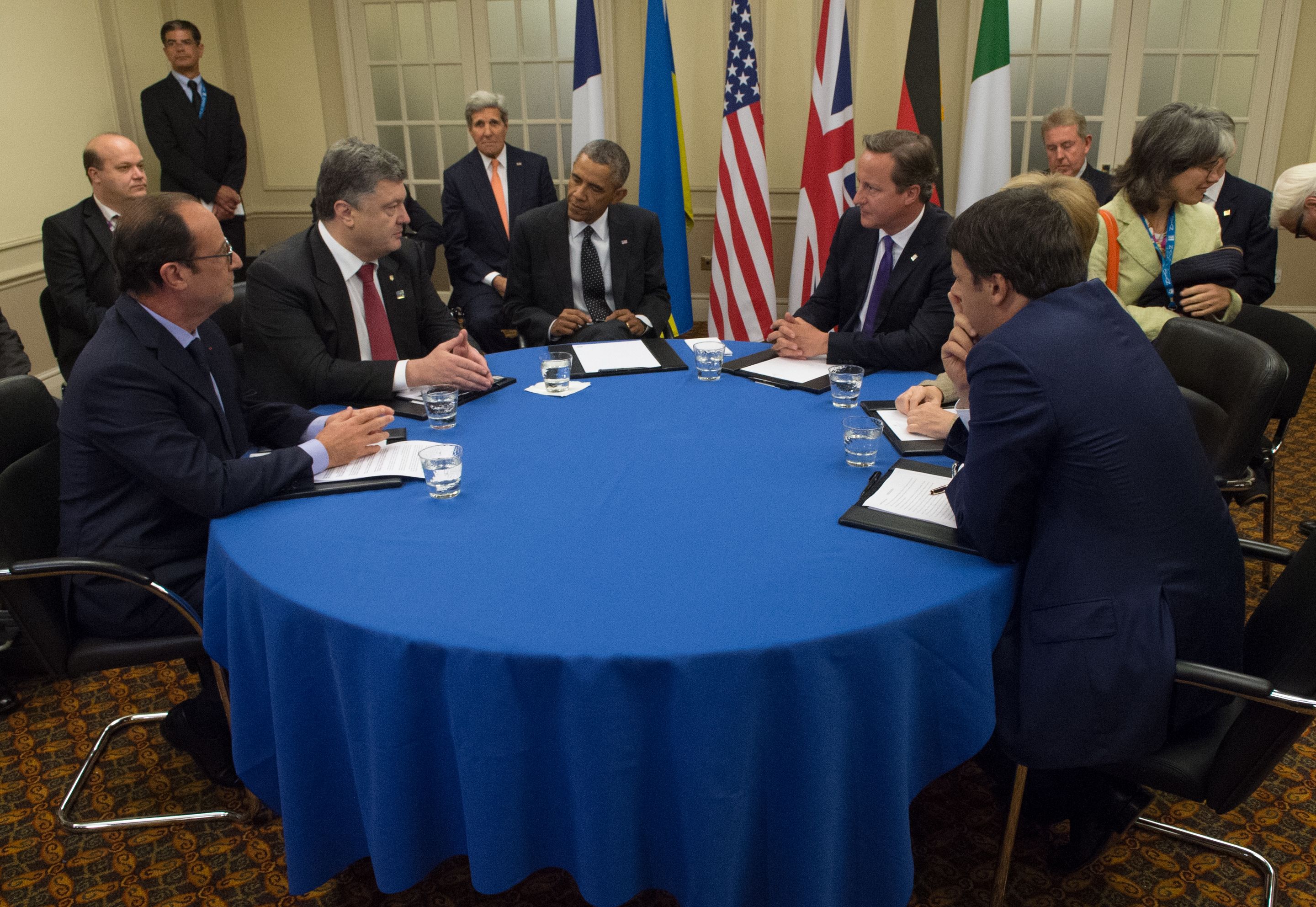
Obama meeting with EU accomplices—notably Cameron (UK), Merkel (Germany) and Holland (France)—as well as Poroshenko, the designated puppet, to discuss the management of their recent coup in Kiev.

Ruins of Donetsk's international airport. The airport was the site of pitched battles between regime forces and separatists

2015: People queue up in Donetsk to get some drinking water. The shelling by the Ukrainian forces has interrupted almost all municipal services and created—as intended—health and sanitary emergencies. In the last 5 years the rebel republics have made enormous progress to repair and rebuild their infrastructure.

Neonazi leader Arseniy Arseniy Yatsenyuk—Victoria Nuland's "picked man"—awarding medals to wounded volunteers, members of proliferating ultra-nationalist formations.
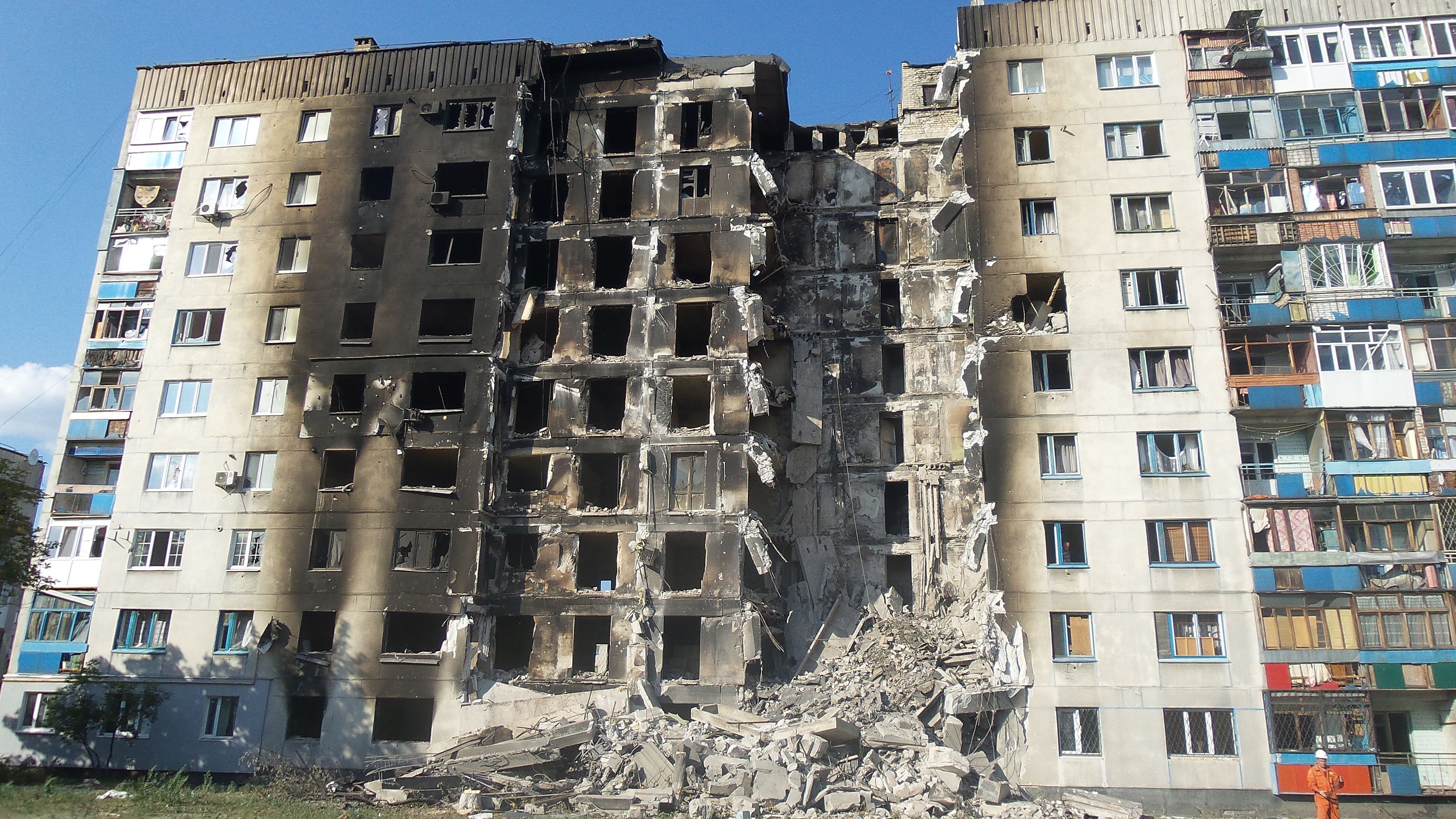
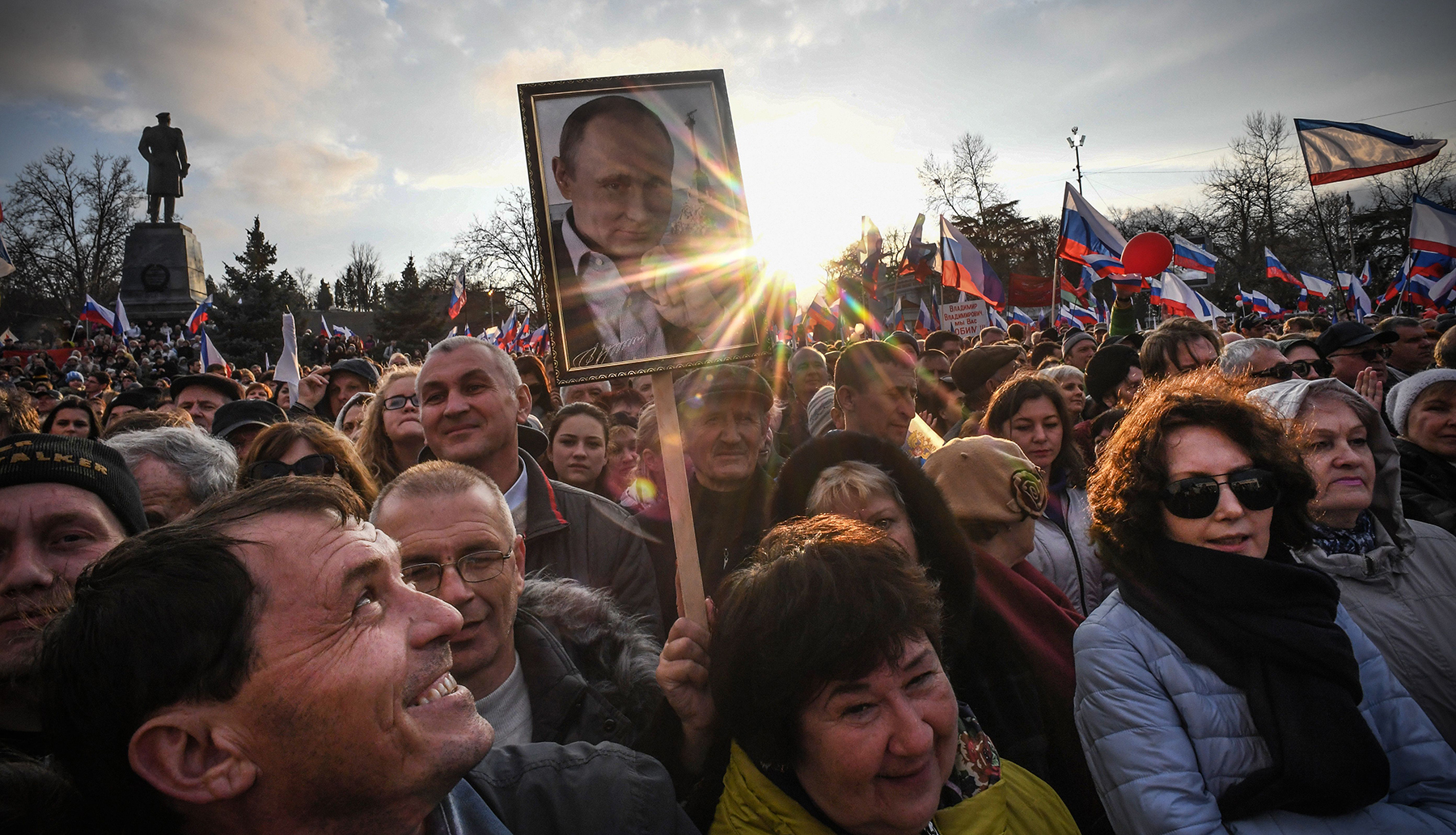
Residents of Sevastopol, Crimea, demonstrate their support for president Putin at Sevastopol's Nakhimov Square on March 14, 2018. They voted overwhelmingly to "return to Russia" to the great displeasure of the West. (Getty Images)

The rebel republics have mustered some light armor. Here some Donetsk assault vehicles on their way to the front. (May 2015). The equipment situation has improved markedly since those days thanks to Moscow's quiet but steady support for the rebels. Putin has said on a number of occasions that Russia will not allow the new neo-Nazi regime in Kiev to massacre the people of Luhansk and Donetsk.
| Did you sign up yet for our FREE bulletin? It's super easy! Sign up to receive our FREE bulletin. Get TGP selections in your mailbox. No obligation of any kind. All addresses secure and never sold or commercialised. |
[premium_newsticker id="211406"]
The views expressed are solely those of the author and may or may not reflect those of The Greanville Post
YOU ARE FREE TO REPRODUCE THIS ARTICLE PROVIDED YOU GIVE PROPER CREDIT TO THE GREANVILLE POST
VIA A BACK LIVE LINK.




